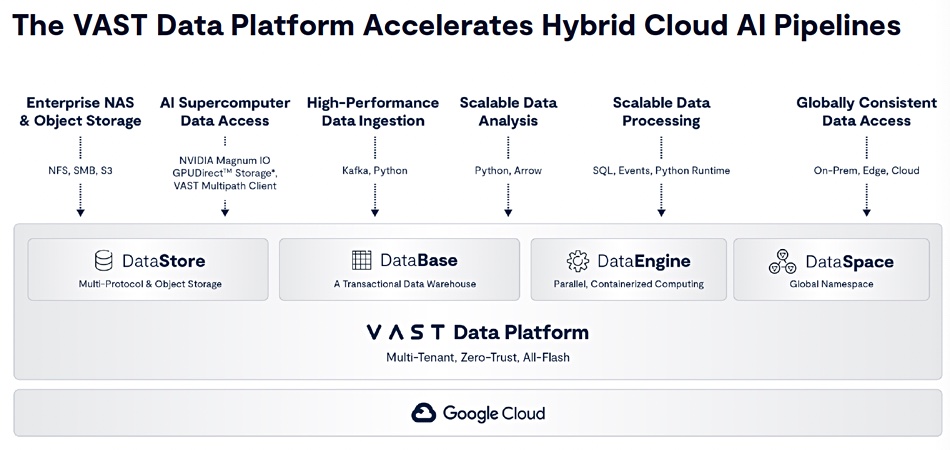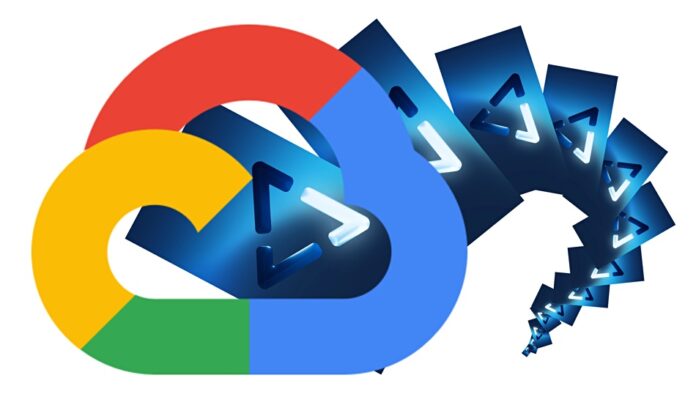VAST Data has ported its Data Platform software to Google’s cloud enabling users to spin up VAST clusters there.
Update: VAST can work with Vertex AI. 12 April 2024.
VAST supplies all-flash storage with a software stack based on a data catalog, global namespace (DataSpace), database, and coming data engine. It began life as an on-premises offering and the software was ported to the AWS cloud in 2023. VAST has a strong focus on AI, forging deals with GPU farm providers such as CoreWeave, and having a Thinking Machines development ambition.

John Mao, VP for Technology Alliances at VAST, said in a statement: “Now we’re enabling Google Cloud customers to take advantage of VAST natively on their preferred cloud platform, simplifying hybrid cloud data management, protection and access to accelerated computing cloud services no matter where their data resides, enabling faster time to value and accelerating innovation.”
VAST declares that its presence in Google Cloud paves the way for seamless hybrid and cloud-native experiences, centralizing data management through a global namespace for file, object, and structured data.
It makes much of this, saying the DataSpace and VAST’s DASE architecture “allows for efficient, limitless scale and collaboration between multiple applications or users across hybrid cloud/multi-location environments without having to manage multiple copies of their data.” VAST says: “Organizations can spin up Spark clusters with Google Cloud and gain radical compute efficiencies through integration with the VAST DataBase.”
The VAST software has a zero trust architecture, featuring granular access control, multi-tenancy with strict isolation, robust encryption, key management, and intelligent threat detection capabilities.

A Solution Brief talks about simplifying, accelerating, and securing hybrid cloud AI pipelines on Google Cloud. It says that VAST in Google Cloud lowers cloud expenses with global data reduction, minimizes data copies, and eliminates API charges. AI development and workloads are enhanced with the VAST Database and Apache Spark.
The brief says globally distributed organizations can collaborate in real time, with predictive prefetching ensuring fast, local access to files across datacenters and GCP regions. A global namespace ensures secure and transparent data access everywhere. There is a seamless, scalable data infrastructure and accelerated AI pipelines in the cloud with elastic compute resources in GCP.
But there is no mention of Google’s Vertex AI, a combination of Google’s cloud-based machine learning and AI services for developing, deploying, and managing machine learning (ML) models across the ML lifecycle. Vertex AI is integrated with Google’s Cloud Storage, BigQuery, and Dataflow for end-to-end data and AI integration.
VAST’s solution brief says the Google Cloud presence means using “on-premises data in GCP has never been easier with the platform’s global namespace, enhancing collaboration and innovation. It’s a game-changer for efficiently managing and leveraging data across hybrid environments, significantly improving performance and cost-efficiency in cloud-based AI and analytics projects.”
Vertex AI is Google’s offering for “cloud-based AI and analytics projects.” It is curious that VAST is not declaring any integration with Vertex AI and this is maybe because VAST and Vertex AI are competing. We have asked VAST why Vertex AI is not mentioned in its announcement and co-funder Jeff Denworth said: “Vertex is an MLOps that you can use to build foundation models and train them against your data for model fine tuning. It’s not specific to any one data source, so, yes, you can use VAST in conjunction with Vertex to train on VAST files, objects and tables.”
Bootnote
We think that VAST will port its data storage software and services to Microsoft Azure some time later this year, thus completing a major public cloud trifecta. It may also add some kind of support for Intel’s Gaudi3 GPU.








